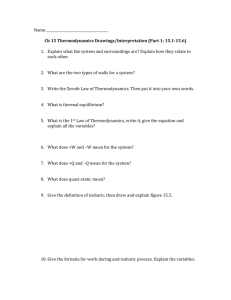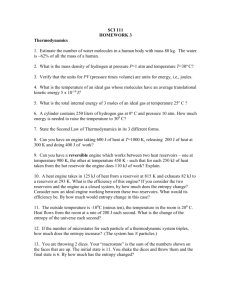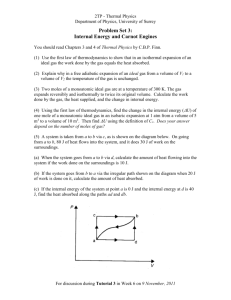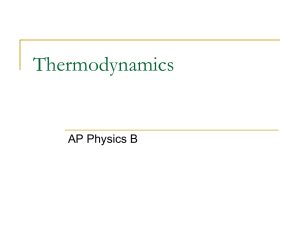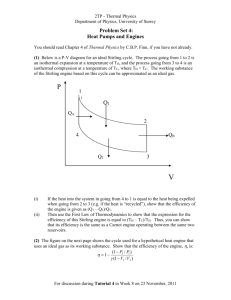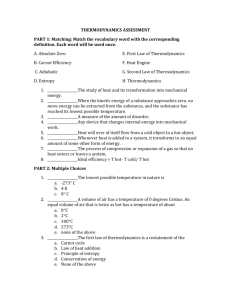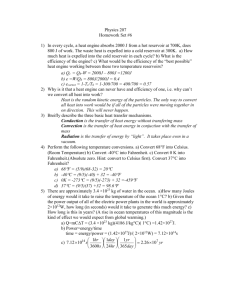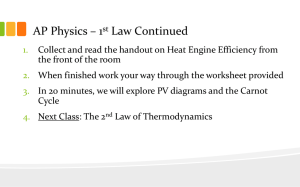Thermodynamics_Review
advertisement
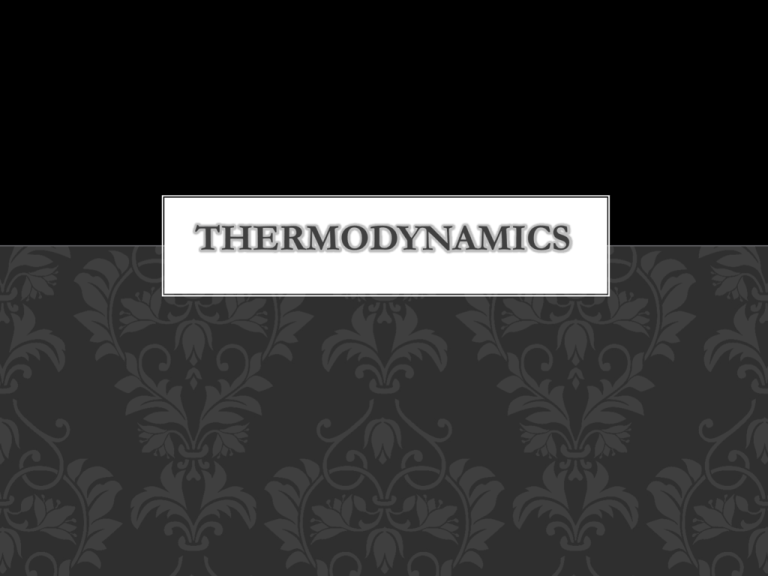
THERMODYNAMICS ZEROTH LAW OF THERMODYNAMICS If two objects are each in equilibrium with a third object, they are also in thermal equilibrium with each other. AVERAGE TRANSLATIONAL KE Notice that the kinetic energy of the molecule only depends on temperature The temperature of a gas is a direct representation of the average energy of the molecules in the gas AVERAGE KINETIC ENERGY Kinetic Molecular Theory: There’s a huge number of molecules. Practical Application: We need to use the average speed to find the kinetic energy. Find it from the equation for the average molecular kinetic energy: ROOT MEAN SQUARE SPEED It’s exactly what you’d expect with a couple notes • μis the mass of the molecule • Boltzmann Constant vs. the Universal Gas Constant On the AP equation sheet: CHEMISTRY REVIEW Universal Gas Constant vs. Boltzmann Constant • Boltzmann decided it would be useful if we knew what the gas constant was per molecule instead of per mole R kb = N0 • Does it work? UNIT WARNING Unlike chemistry • Temperature is always measured in Kelvin K = oC + 273.15 • Molar Mass must be in kg/mol FIRST LAW OF THERMODYNAMICS Conservation of energy, but this time with respect to gases in the kinetic theory of ideal gases • Adding heat and doing work on a gas increases its internal energy • Removing heat and allowing the gas to do work decreases its internal energy INTERNAL ENERGY OF A SUBSTANCE A convenient model is that atoms vibrate like they’re connected by springs • Kinetic energy as they oscillate • Potential energy that binds them together INTERNAL ENERGY All gas has a certain amount of internal energy At a MICROSCOPIC level, not macroscopic DU =U f -Ui ΔU is positive when internal energy increases HEAT Heat is the transfer of energy, not energy itself Units: Joules Symbol: Q If we add heat to a system, we are really adding energy to its internal energy • Q is positive when work is done on the system • Q is negative when work is removed from the system We’re back to Work1 Work can be performed on gases • Example: Push down on the piston of a cylinder of gas, reducing its volume. • If we smush the molecules together like this, then we are increasing the collisions that will happen in that smaller volume. Doing work on the gas increases the internal energy. • Work is positive when it is done on a system. Footnote: 1 Pun intended We’re back to Work1 Gases can do Work • Example: the gas pushes the cylinder back up, increasing its volume. • In this case the gas has done the work, so the internal energy of the gas decreased. • Work is negative when it is done by the system FIRST LAW OF THERMODYNAMICS We measure how much we changed the internal energy of the system by adding/removing heat and doing work on/by the gas. IDEAL GAS LAW Show that these two forms are equivalent Boyle’s Law is just one implication of the Ideal Gas Law PV DIAGRAMS There are four different situations that you can expect to see shown in PV diagrams: 1. Isobaric: the gas is held at a constant pressure 2. Isochoric: the gas is held at a constant volume 3. Isothermal: the gas is held at a constant temperature 4. Adiabatic: No heat flows in or out of the gas Isobaric –What happens We place a heat source under a cylinder • Since this is an isobaric process, the pressure must stay the same as it was at the start. • We also expect that with the extra internal energy the molecules have gained from the heat source, they will be bouncing around a bit more. • This must result in the gas expanding in the cylinder ISOBARIC PV DIAGRAM The PV diagram shows a gas going from a smaller to a bigger volume, while the pressure stays constant. Note: The area underneath the line is PV = Work ISOCHORIC In an isochoric process the gas must keep a constant volume, so we will put the gas in a sealed container that can not change size or shape. Pressure increases No Work done From the First Law: Since no Work is done, the added heat just increases the internal energy ISOCHORIC PV DIAGRAM This is consistent • No area => no Work The Ideal Gas Law is also consistent • The pressure increase is due to heat being added, which in turn directly affect the internal energy ISOTHERMAL Temperature remains constant • As the volume of a gas expands the pressure would need to drop Work is being done by the gas (work is negative), so to keep the internal energy (and temperature) constant, the gas must be absorbing heat from the water. As long as the energy lost (by the gas doing work) equals the heat gained from the water, the internal energy will not change and the temperature stays the same. ISOTHERMAL PV DIAGRAM Pressure and volume both change Line of constant temperature called an isotherm Area underneath is the Work done, but you can’t find it without calculus since it’s curved ADIABATIC No heat is added to the system This is NOT the same as isothermal, the temperature can change Q = 0 J, so according to the First Law • If the gas is compressed (work done on the gas is positive) the internal energy increases. • If the gas expands (work done by the gas is negative) the internal energy decreases. ADIABATIC PV DIAGRAM Looks similar to isothermal, but drops off so it must begin and end on different isotherms As we've already discussed, in the adiabatic process where a gas expands, the work done by the gas causes the internal energy to decrease, so the temperature must decrease as well. INTERNAL ENERGY AGAIN Since ΔU = W for an adiabatic process, if we figure out the initial and final internal energies, we can figure out the work done on or by the gas without having to use calculus to figure out the area under the PV curve. The following is not on your equation sheet: SUMMARY OF PROCESSES SECOND LAW OF THERMODYNAMICS Heat will always spontaneously flow from a hotter to a colder object. Or, in physics speak: The entropy of a closed system shall never decrease and shall increase whenever possible. ENTROPY Entropy is a measure of the disorder of a system. All systems tend toward an increase in entropy unless Work is done on them HEAT ENGINES A heat engine uses energy to perform work • The heat that is the input to run the engine comes from an area at a higher temperature, called a hot reservoir. • Some of the input is used to do some actual work. This is the output that we actually want. • The rest of the heat is released (basically as waste) to a cold reservoir. HEAT ENGINES This obeys the 1st and 2nd laws • The input heat is equal to the Work done plus the heat released (1st law) • The heat is flowing from the hot to cold reservoir (2nd Law) EFFICIENCY The more Work an engine produces from the input heat, the more efficient the engine Efficiency is found by dividing • W: the work done, by • QH: the input heat from the hot reservior EFFICIENCY EQUATION #2 Using the notation of • QH as the input heat from the hot reservoir • QC as heat flowing to the cold reservior The first law can be rewritten QH = W + Q C Which we can rearrange if we want to W = Q H - QC EFFICIENCY EQUATION #2 A heat engine is running with an input of heat of 1.45 x 104 J. If it dumps 1.02 x 104 J of waste heat into its surroundings, determine the efficiency of the engine. Combining this equation for the first law with the equation for efficiency QC e = 1QH CARNOT HEAT ENGINE By the early 1800s scientist were asking if there were a limit to how efficient an engine could be Sadi Carnot proved the efficiency, he said • The heat engine reaches its maximum efficiency when all of the steps are reversible • Reversible means that the engine (the system) and everything around it (the surroundings) can return to the same state they were in before the engine was running • Friction gets in the way of real life engines being reversible and the second law can also CARNOT ENGINE Is useful despite not actually being possible since every real world engine must be less than the Carnot engine efficiency for the same situation CARNOT ENGINE The best possible engine would be one that did the most work based on the temperature difference that it had available between the two reservoir It can be shown that the ratio of the heat of the two reservoirs is equivalent to the ratio of their temperatures. CARNOT ENGINE We can substitute this into the second equation for efficiency we came up with Even in Carnot's perfectly reversible engine, there must be a difference in temperature between the two reservoirs, so that heat can flow on its own REFRIGERATORS AND HEAT PUMPS Heat won’t flow on its own from cold to hot, but we can force it to! A refrigerator is a heat engine in reverse, we do work to move heat from a cold reservoir to a hot reservoir Can you think of another example? HEAT PUMP A heat pump is a device that works like a refrigerator, except that it is used to heat a building in cold weather. • For a heat pump, the cold reservoir is the outdoors, and the hot reservoir is the inside of the building. • Electricity is used to do the work of pumping the heat.



